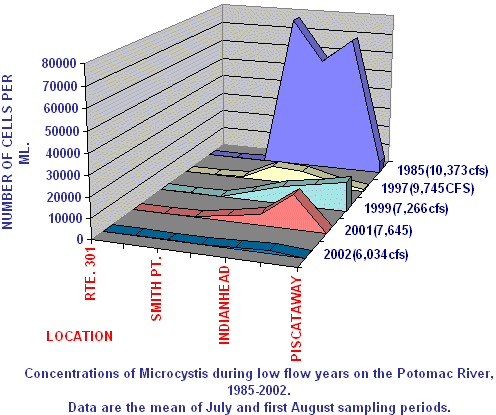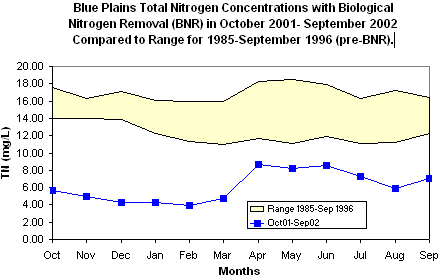|
November 20, 2002
Record low Microcystis levels on the Potomac River during 2002. |
Monitoring by the Maryland Department of Natural Resources and the Academy of Natural Sciences this year on the Potomac River showed blooms of the bluegreen alga, Microcystis aeruginosa, were essentially absent from the region. Samples are collected downstream of Washington, D.C. between Piscataway Creek and the Rt. 301 Bridge. Summer concentrations in July and August were extremely low and below bloom levels observed during other low flow years (see figure below). Low levels of this frequently abundant algae also contributed to record high water clarity values since 1986 at the Indian Head monitoring station for July (Secchi depth = 0.8m tied for maximum observed) and September (Secchi depth = 0.9m, previous record 0.8m) (see Marylands Eyes on the Bay website).
Initial improvements in phosphorus management at Blue Plains Wastewater Treatment Plant (WWTP) date back to the mid-1970s. Additional actions to reduce phosphorus in the region occurred with the phosphate ban in the 1980s for Maryland, Washington D.C. and Virginia. These earlier efforts initially aided in reducing noxious algal blooms in the Potomac River. Since 1996, biological nutrient removal (BNR) at Blue Plains WWTP has been in place and lowering the concentrations of nitrogen (another key nutrient for plankton growth) entering the Potomac River. This year, drought conditions resulted in low flow conditions and, along with the BNR upgrades to the Blue Plains WWTP, greatly reduced nitrogen delivered to the river versus the pre-BNR period (See Blue Plains figure below). These reductions in nutrient loads likely translated to the near absence of Microcystis which tends to prefer nutrient rich waters for its explosive population growth. |


